Microplastic pollution in the Arctic
| Project Acronym: PolarPlastics
Area: Tromsø to west of Svalbard Research Vessel: RV G. O. Sars, IMR and UiB, Bergen Chief scientist: Amy Lusher, Galway-Mayo Institute of Technology Other project partners: OGS, Trieste, Italy Date: 5 th -15 th June 2014 |
RV G. O. Sars ©Ardo Robijn |
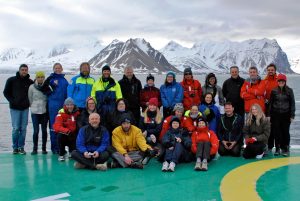
PolarPlastics and PREPARED Cruise Teams ©Renata Lucchi |
|
|
|
Amy Lusher, Galway-Mayo Institute of Technology, Ireland “I applied to Eurofleets2 Polar and Subpolar call as a single researcher requesting a berth on a research vessel that would be carrying out its primary research in Arctic waters. As a PhD researcher it is relatively hard to acquire data. I was interested in looking for microplastics in polar waters, because at the time, there was no evidence of microplastics in polar waters. |
Main Objectives
The main aim of the project was to collect and make an assessment of the abundance and distribution of microplastics in polar waters. We had 5 main objectives:
|
| A little background on microplastics.
What are they: Microplastics are small pieces of plastic less than <5mm, they come from the breakdown of larger plastic items or from direct input as small plastic pellets, scrubbers in cosmetics, plastic powders which are used for air blasting ships hulls. Microplastic fibres can also come from the breakdown of ropes in the marine environment, or from washing synthetic clothing and fibres are not removed at sewage treatment works. Why are they an issue in the ocean: Monitoring the accumulation and fate of microplastics in the marine environment are of particularconcern as they are almost, if not impossible, to remove. Once in the marine environment they can be transported through the water column, from surface waters, to the deep sea sediments, wash up on beaches and accumulate on strandlines worldwide. Distribution in the ocean is often governed by prevailing winds and ocean currents, which could see transport of microplastics to isolate areas, far from plastic production. Microplastics could be mistaken by organisms as prey, and ingested. Laboratory studies have started to look at the effects of ingestion. Before we can identify which organisms are affected in polar waters, we must first identify their distribution. |
Work progress and main achievements
| There were three main elements to our research, the primary task was to adapt a sampling technique that we had already developed for the Irish national research vessel, R.V. Celtic Explorer. It involved finding the intake of seawater on the vessel, running a hose around the desk and filtering 1000 litres of water every hour. We collected our samples using a sieve set up on the back deck. Each sample was re-suspended and transferred to the lab, where we then filtered it down and froze the sample for analysis in a contamination free environment in the laboratory. We collected 80 samples, and initial analysis has revealed microplastic particles throughout the survey area. Our second task was to utilize a method of microplastic sample collection known as a manta net. It is Our third task was to collect sediment samples from suitable locations in the survey area. We Additionally, we will look at the influence of oceanographic features on the distribution of Overall the information we gather from our analysis will allow us to make inferences into the levels of |
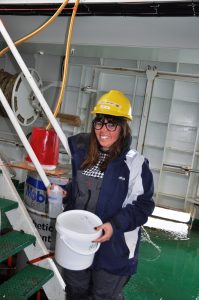
Heidi Acampora taking samples from the |
|
|
|
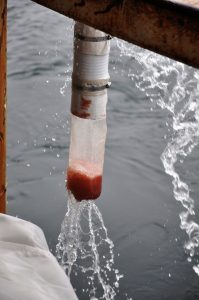
Cod end of manta net filled with sample ©Giulia |
For more information:
|
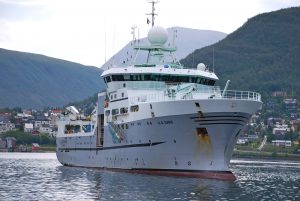
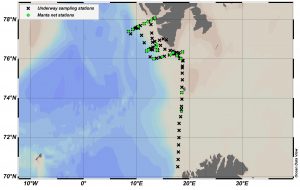 Cruise Map ©Amy Lusher
Cruise Map ©Amy Lusher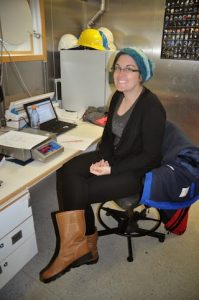 Amy Lusher ©Renata Lucchi
Amy Lusher ©Renata Lucchi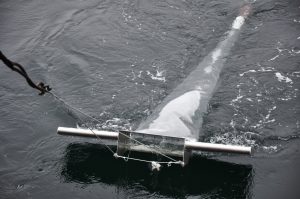 Manta net sampling surface waters ©Giulia
Manta net sampling surface waters ©Giulia